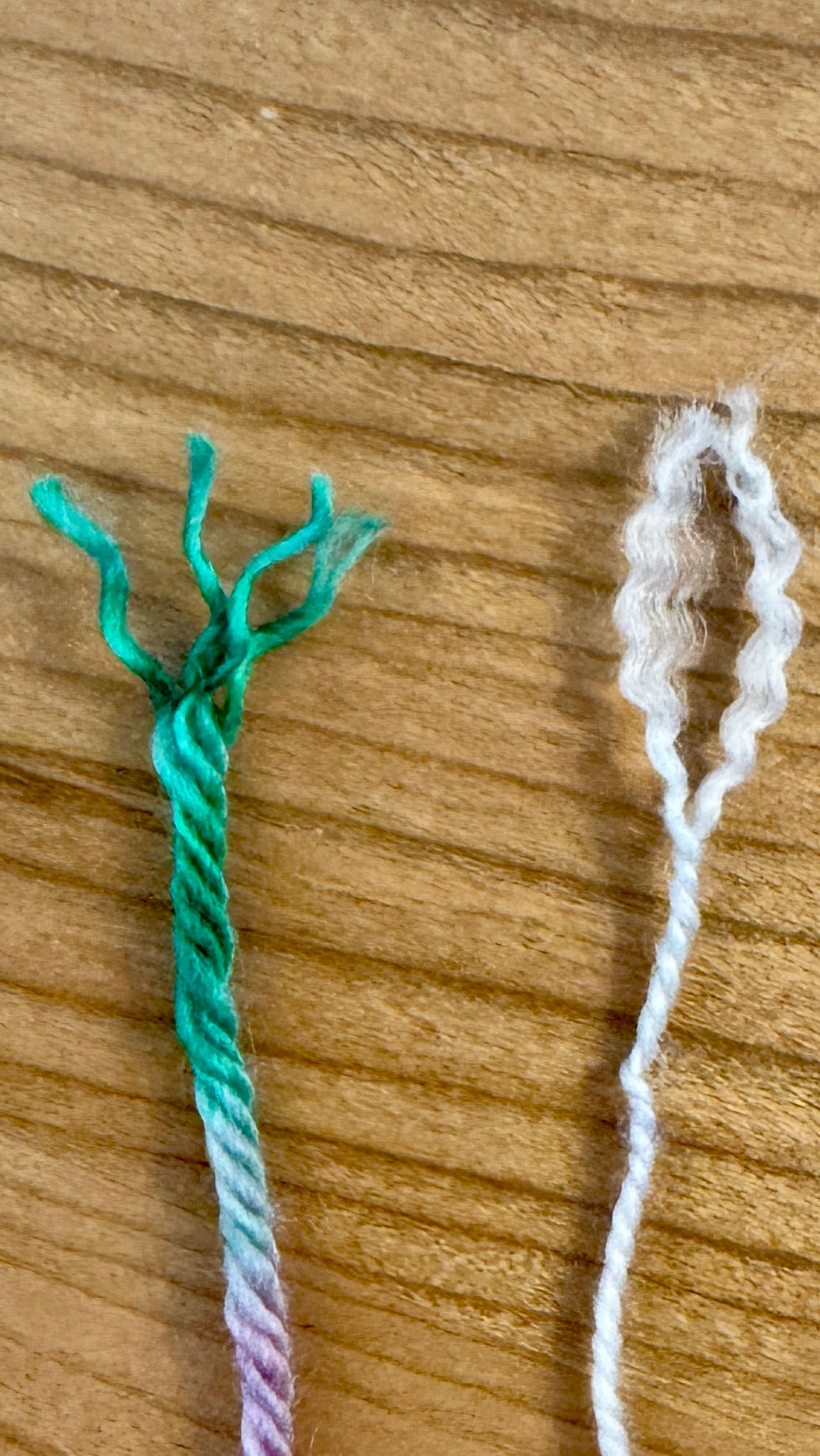Understanding Yarn Bases: What’s the Difference?
- Stephanie
- Sep 25
- 3 min read
Fingering vs. DK, Merino vs. Blends, and how to choose the right yarn for your project
If you’ve ever shopped for yarn and found yourself staring at the labels wondering what fingering, DK, merino, or blend really mean — you’re not alone. Yarn bases can be confusing at first, but understanding them will make your knitting or crochet projects smoother, more enjoyable, and perfectly matched to your vision.
Let’s break down the basics so you can shop (and stitch!) with confidence.

Yarn Weight & Texture
Yarn weight refers to the thickness of the yarn strand — not how heavy the skein is. Texture also plays a role in how the yarn feels and behaves. Note: Always follow the gauge stated in your pattern! We all knit/crochet with different tension, and our needle/hook sizes may vary from the guidelines listed below. Use whatever needle/hook size that gives you the correct gauge!
Suri Alpaca Lace
Texture & Feel
Light, airy, and incredibly soft with a beautiful halo.
Made from the longer, silkier fibers of the suri alpaca breed, often blended with silk for strength and sheen.
Uses
Perfect for adding a halo to projects, carrying along with another yarn, or knitting/crocheting into lightweight, fluffy garments.
Great for: airy sweaters, cowls, shawls, soft scarves.
Gauge
33-40 stitches over 4" on US 000-1 (1.5-2.25 mm) needles.
32-42 double crochet (DC) over 4" on US B-1 (2.25 mm) hook.
Lace weight yarns are often worked on larger needles/hooks than the strand suggests (US 4–8 / 3.5–5 mm needles) for an open, drapey fabric.
Fingering Weight
Texture & Feel
Also called sock yarn, it’s thin and versatile with excellent stitch definition.
Uses
Great for: socks, shawls, lacework, lightweight sweaters.
Gauge
27–32 stitches over 4" on US 1–3 (2.25–3.25 mm) needles.
21-32 single crochet (SC) over 4" on US B-1 to E-4 (2.25-3.5 mm) hook
Sport Weight
Texture & Feel
Slightly thicker than fingering but lighter than DK, making it a great “in-between” option.
Uses
Perfect for: baby items, lightweight garments, colorwork, accessories.
Gauge
23–26 stitches over 4" on US 3–5 (3.25–3.75 mm) needles.
16-20 SC over 4" on US E-4 to 7 (3.5-4.5 mm) hook.
DK Weight
Texture & Feel
Double knitting weight — balanced between drape and warmth.
Uses
Great for: sweaters, hats, scarves, baby blankets.
Gauge
21–24 stitches over 4" on US 5–7 (3.75–4.5 mm) needles.
12-17 SC over 4" on US 7 to I-9 (4.5 to 5.5 mm) hook.
Worsted Weight
Texture & Feel
A workhorse yarn: thicker and warmer, knits up quickly.
Uses
Great for: cozy sweaters, blankets, winter accessories.
Gauge
16–20 stitches over 4" on US 7–9 (4.5–5.5 mm) needles.
11-14 SC over 4" on US I-9 to K-10.5 (5.5 to 6.5 mm) hook.
Fiber Content: Merino vs. Blends
Fiber type affects softness, warmth, durability, and how your yarn behaves in the dye pot.
100% Merino Wool – Luxurious softness, excellent stitch definition, breathable, and versatile.
Wool/Nylon Blends – Extra durability for socks and high-wear items.
Other Blends – Wool + silk for sheen, wool + alpaca for warmth and halo, wool + cashmere for luxury.
Superwash vs. Non-Superwash
Superwash Wool – Treated to prevent felting; machine washable (gentle cycle); takes dye vibrantly.
Non-Superwash Wool – Untreated, with more “grip” for colorwork; felts intentionally; often has a more rustic feel.
How to Choose the Right Base
Match the yarn weight to your pattern for correct gauge and drape.
Think about fiber needs — softness for shawls, durability for socks, drape for summer tops.
Consider care instructions — machine washable for easy-care gifts, non-superwash for heirloom knits.
Why It Matters for Hand-Dyed Yarn
Different yarn bases take dye differently. A superwash merino fingering might give you intense, saturated color, while a suri alpaca lace might produce a soft, watercolor-like halo. At Greenstone Yarn, I hand-select bases that highlight both the beauty of the dye and the joy of working with them — whether you’re knitting delicate lace or a cozy cardigan.
Ready to explore?
Browse Greenstone Yarn’s shop to find the perfect base for your next project — and feel the difference a thoughtfully chosen yarn can make.









Comments